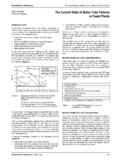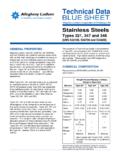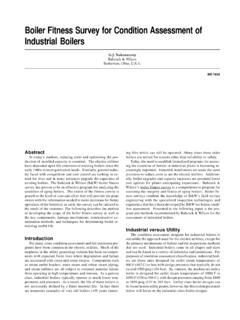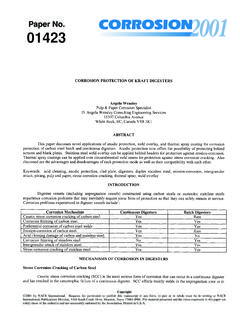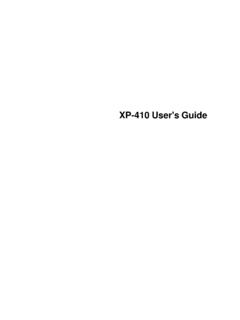Transcription of Technical Data BLUE SHEET - METSERVE
1 Allegheny Ludlum Corporation Pittsburgh, PABLUE SHEETT echnical DataMartensiticStainless SteelsTypes 410, 420,425 Mod, and 440 AData are typical and should not be construed as maximum or minimum valuesfor specification or for final design. data on any particular piece of material mayvary from those shown PROPERTIESA llegheny Ludlum types 410, 420, 425 Modified, and440A (see composition on Page 2) are hardenable,straight-chromium stainless steels which combinesuperior wear resistance of high carbon alloys with theexcellent corrosion resistance of chromium stainlesssteels. Oil quenching these alloys from temperaturesbetween 1800 F to 1950 F (982-1066 C) producesthe highest strength and/or wear resistance as well ascorrosion resistance. A range of as-quenchedhardnesses is achieved in these alloys by varying thecarbon level from .15% maximum in Type 410 to . in Type alloys are used where strength, hardness, and/or wear resistance must be combined with major use for these grades of heat treatable stain-less steels is in cutlery.
2 Depending on the customer'send-use requirements, cutlery alloys are usuallyselected with respect to heat treating response,mechanical properties and fabricating sufficient amounts of carbon are added tostraight- chromium stainless steels, the alloy then hasthe capability to transform its microstructure throughproper heat treatment (hardening) into one that willpossess optimum strength, hardness, edge retention,and wear resistance. The presence of sufficientchromium will impart the necessary corrosion resis-tance and form chromium carbide particles thatenhance the wear resistance of the given alloy. Thehigher the carbon content, the greater the amount ofchromium carbide particles, and the greater thestrength and hardness for heat treatable straight-chromium stainless blanking cutlery parts from annealed rawmaterial stock, types 410, 420, and their highercarbon versions ( types 410HC and 420HC) willusually exhibit hardness, yield strength, and tensilestrength that are low enough for fine blanking pur-poses.
3 However, Type 440A is not readily amenable tofine blanking due to its higher strength and hardnessin the annealed condition; and therefore, could requiremore powerful presses to blank parts. In addition, thepresence of large primary carbides in Type 440 Awould tend to reduce die buffing blanked parts, the higher hardness ofType 440A in the heat treated condition (hardened)would mean less residual buffing lines on the surfacesof parts but the large primary carbides could bedislodged during buffing which would producescratches called comet-tails . Stainless steels lower incarbon content are essentially free of "comet-tails".Other applications for these grades include dental andsurgical instruments, nozzles, valve parts, hardenedsteel balls and seats for oil well pumps, separatingscreens and strainers, springs, shears, and FORMT hese alloys are available as plate, SHEET , strip andflat are typical and should not be construed as maximum or minimum valuesfor specification or for final design.
4 data on any particular piece of materialmay vary from those shown SteelVisit our Website atTypes 410, 420,425 Mod, and (427)104 (717)2057-60 Type 425 (379)94 (648)2457-6089*45 (310)86* (593)25*Type 420HC** (310)87 (600)2856-59 Type (310)85 (586)2953-57 Type 410HC** (310)78 (538)3045-52 Type (290)74 (510)3438-45 Typical AnnealedProperties* Fine blanking quality**HC means higher carbon version of standard gradeStainlessSteelsTypical Composition(Weight Percent) OffsetYield StrengthKsi (MPa)TensileStrengthKsi (MPa)Elongation,Percent in2" (51 mm)*A higher carbon version of Type 410 is also available called Type 410HC (nominal C).**A higher carbon version of Type 420 is also available called Type 420HC (nominal C).CHEMICAL COMPOSITIONType 410*Type 420**Type 425 ModType 440 AElement in Weight PercentCarbonManganeseSilicon ChromiumMolybdenum max max max max max max max max max maxMECHANICAL PROPERTIEST ypical compositions, annealed mechanical propertiesand hardening response for the various AlleghenyLudlum martensitic stainless steels are data blue SHEETData are typical and should not be construed as maximum or minimum valuesfor specification or for final design.
5 data on any particular piece of materialmay vary from those shown shown below give typical mechanical propertiesof martensitic stainless steels obtained with variousdrawing temperatures after austenitizing at 1800-1950 F (982-1066 C) followed by an oil quench and atwo hour temper. Heat-to-heat variations can Mechanical Properties of Heat Treated Martensitic Stainless SteelsAnnealed*81 85 90 94 (313) (554)(355) (592)(396) (595)(354) (747)Hardened+Tempered43 HRC 48 53 54 HRC F(1076) (1399)(1311) (1759)(1385) (1868)(1579) (2022)(204 C)Hardened+Tempered40 HRC 44 50 50 HRC F(1022) (1289)(1213) (1583)(1360) (1729)(1518) (1879)(288 C)Hardened+Tempered40 HRC 45 53 53 HRC F(1026) (1283)(1234) (1606)(1351) (1690)(1531) (1883)(316 C)Hardened+Tempered41 HRC 46 53 53 HRC F(916) (1300)(1280) (1627)(1452) (1759)(1610) (1881)(427 C)Hardened+Tempered41 HRC 46 52 52 HRC F(845) (1298)(1236) (1606)(1368) (1619)(1466) (1858)(482 C)
6 Hardened+Tempered35 HRC 36 43 41 HRC F(882) (1063)(951) (1093)(1218) (1434)(1013) (1224)(538 C)Hardened+Tempered98 23 29 31 HRC F(589) (767)(652) (838)(743) (936)(727) (933)(649 C)HeatTreatmentT410 ( %C)Hardened 1800 F (982 C)T420 ( %C)Hardened 1900 F (1038 C)T425 Mod ( %C)Hardened 1900 F (1038 C)T440A ( %C)Hardened 1900 F (1038 C) ,Ksi(MPa)UTS,Ksi(MPa) ,Ksi(MPa)UTS,Ksi(MPa) ,Ksi(MPa)UTS,Ksi(MPa) ,Ksi(MPa)UTS,Ksi(MPa)RockwellHardnessRoc kwellHardnessRockwellHardnessModulus of Elasticity29 x 106 psi (200 GPa)*See Heat Treatment section for annealing informationData are typical and should not be construed as maximum or minimum valuesfor specification or for final design. data on any particular piece of materialmay vary from those shown SteelVisit our Website atTypes 410, 420,425 Mod, and maximum hardness and strength, a hardeningheat treatment is necessary.
7 The stainless steel alloysshown in the table on Page 3 were heated as sheetsamples for 60 minutes per inch of thickness at1800 F (982 C) for Type 410 and at 1900 F (1038 C)for types 420, 425 Modified, and 440A, and then aircooled to room temperature. The as-quenchedstructure of fresh martensite must be tempered torestore some ductility. The samples depicted in thetable were tempered at temperatures from 400 F(204 C) to 1200 F (649 C) for two hours; note thattheir hardnesses and strengths changed very little withincreases in tempering temperature up to 900 F(482 C).PHYSICAL PROPERTIESThe values reported below are typical for the alloys inthe annealed Lbs / in3 Specific Heat Btu/lb. Conductivityat 212 F (100 C) Btu/(hr ft F) W/m KElectrical Resistivity Microhm-cm 68 F (20 C)56566162 Coefficient of ThermalExpansion 68 - 392 F, in/in x x x x 10-6 20-200 C, cm/cm/ x x x x 10-6 68-1112 F, in/in/ x x x x 10-6 20-600 C, cm/cm/ x x x x 10-6 Melting Range2700-2790 F2650-2750 F2600-2750 F2550-2750 F1482-1532 C1454-1510 C1427-1510 C1399-1510 CPropertyType410 Type420 Type425 ModType440 ATechnical data blue SHEETData are typical and should not be construed as maximum or minimum valuesfor specification or for final design.
8 data on any particular piece of materialmay vary from those shown RESISTANCET ypes 410, 420, 425 Mod, and 440A exhibit goodcorrosion resistance to atmospheric corrosion, potablewater, and to mildly corrosive chemical enviromentsbecause of their ability to form a tightly adherent oxidefilm which protects their surfaces from further Corrosion Behavior Compared With Other Nonaustenitic Stainless Steels*As shown in the above table, these alloys have goodcorrosion resistance to low concentrations of mildorganic and mineral acids.*Hardened Martensitic grades were tested after tempering at 400 F (204 C). Test samples had ground surfaces.*Hardened martensitic grades were tested after tempering at 400 F (204 C).Their exposure to chlorides in everyday type activities( , food preparation, sport ) is generallysatisfactory when proper cleaning is performed afterexposure to use. See additional comments oncorrosion properties under the section SurfacePreparation.
9 Effect of Chlorides on the Anodic Polarization Behavior Compared With OtherNonaustenitic Stainless Steels*Potentiodynamic anodic polarization measurements,as shown above, can be used to determine therelative resistance of a stainless steel to the initiationof localized chloride attack (pitting and crevice corro-sion). With this technique the breakdown potential ismeasured, and is defined as the potential at which theanodic current increases rapidly due to initiation oflocalized attack. The more positive or noble thebreakdown potential the more corrosion resistant thealloy. The above table presents the average break-down potential for the hardenable alloys as well asTypes 430 and 409 for anodic polarization results show that alloys suchas Type 425 Mod, Type 440A, and Type 430 with theirhigher chromium or combination of chromium andmolybdenum contents are more resistant to localizedchloride ( )( )( )( )( )( )Phosphoric( ( )( )( )( )( )( )5% Test Solutionat 120 F (49 C)Corrosion Rate in Mils per Year and Millimeters per Year (mm/a)TypeTypeTypeTypeTypeType4094104204 25 Mod440A430 Test Solution at75 F (24 C), pH 5 Breakthrough Pitting Potential [Volts vs SCE] in Sodium Chloride SolutionTypeTypeTypeTypeTypeType40941042 0425 Mod440A430100 ppm are typical and should not be construed as maximum or minimum valuesfor specification or for final design.)
10 data on any particular piece of materialmay vary from those shown SteelVisit our Website atTypes 410, 420,425 Mod, and PROPERTIESM achiningThese alloys should be machined in the annealedcondition using surface speeds of 60 to 80 feet ( m) per PreparationFor maximum corrosion resistance to chemicalenvironments, it is essential that the stainless steelsurface be free of all heat tint or oxide formed duringforging, annealing, or heat treating. All surfaces mustbe ground or polished to remove any traces of oxideand surface decarburization. The parts should then beimmersed in a warm solution of 10-20% nitric acid toremove any residual iron. A thorough water rinseshould follow the nitric acid the annealed condition, types 410, 420, 425 Mod,and 440A consist of ferrite and carbides. Highercarbon and higher chromium material such as Type440A in the annealed condition will also contain largescattered primary carbides.
